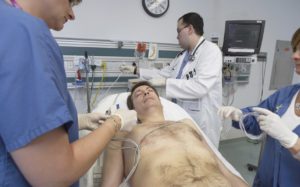Watch More! Unlock the full videos with a FREE trial
Included In This Lesson
Study Tools
Access More! View the full outline and transcript with a FREE trial
Outline
Mr. Logan is a 32-year-old male with a history of DM Type I. He presented to the Emergency Department (ED) after being found by his family with decreased LOC, rapid heavy breathing, and fruity breath. His family reports flu-like symptoms for the last few days.

Before even gathering further information - what do you think is going on? Why?
Diabetic Ketoacidosis – he is a Type I Diabetic with heavy breathing (Kussmaul Respirations) and fruity breath. These are classic signs. It’s important to recognize them and immediately begin anticipating the patient’s needs.
What diagnostic or lab tests would you expect the provider to order?
- Complete metabolic panel to check serum glucose, anion gap, potassium, etc.
- Arterial Blood Gas to assess for acidosis
- Urinalysis to look for ketones
The nurse draws a Complete Metabolic Panel and notifies the Respiratory Therapist to obtain an Arterial Blood Gas. Upon further assessment, the patient is oriented x 2 and drowsy. He is breathing heavily. Lungs are clear to auscultation, S1/S2 present, bowel sounds active, pulses present and palpable x 4 extremities. A POC glucose reads >450 (meter max).
Vital signs are as follows:
HR 87
RR 32
BP 123/77
SpO2 96%
Mr. Logan’s labs result and show the following:
Glucose 804 mg/dL
K 6.1 mEq/L
BUN 39 mg/dL
pH 7.12
Cr 1.9 mg/dL
pCO2 30
Anion Gap 29 mEq/L
HCO3– 17
Urine = Positive for Ketones
Using these lab results, explain what is going on physiologically with Mr. Logan.
What is the #1 priority for Mr. Logan at this time?
The provider writes an order for an Insulin Lispro infusion IV, titrating to decrease blood glucose per protocol, 1L NS bolus NOW, and a continuous infusion of Normal Saline IV at 250 mL/hr, and to change the fluids to D5 ½ NS at 125 mL/hr once the blood glucose level falls below 250 mg/dL.
The provider adjusts the order to Regular Insulin IV infusion. Orders are also written for hourly POC glucose checks and a q2h BMP. After 4 hours and another 1L bolus of NS, Mr. Logan’s blood glucose level has dropped to 174 mg/dL, but his anion gap is still 19. The nurse changes his fluids to D5 ½ NS per the order and continues the insulin infusion. The most recent BMP showed a K of 3.7, down from 6.1, so the provider orders to give 40 mEq of KCl PO. After another 4 hours, Mr. Logan’s anion gap is now 12, a repeat ABG shows a pH of 7.36 with normal CO2 and HCO3– levels. The nurse begins to transition Mr. Logan off of the IV infusion to SubQ insulin per protocol. He is feeling much better and says he’s embarrassed that he had to be brought to the hospital.
What is the first action you should take after receiving these orders?
Remind the provider that the only insulin that can be given IV is Regular Insulin and request that he change the order. Call the Pharmacist if you have to
Why is it important to check a BMP frequently? What are we monitoring for?
Why is the insulin continued even after the blood glucose decreases?
What education can you provide Mr. Logan to help him understand why this happened and how to prevent it from recurring in the future?
View the FULL Outline
When you start a FREE trial you gain access to the full outline as well as:
- SIMCLEX (NCLEX Simulator)
- 6,500+ Practice NCLEX Questions
- 2,000+ HD Videos
- 300+ Nursing Cheatsheets
“Would suggest to all nursing students . . . Guaranteed to ease the stress!”
~Jordan